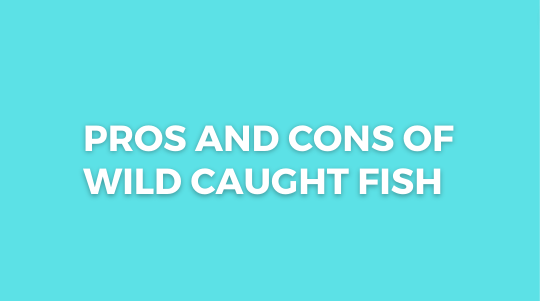Wild-caught fish refers to fish that are harvested from natural habitats, such as oceans, lakes, or rivers.This is in contrast to farmed fish, which are raised in controlled environments like fish farms or aquaculture facilities. Below are pros and cons of wild-caught fish:
Pros:
- Natural flavor and texture: Wild-caught fish often have a more distinct and robust flavor compared to their farm-raised counterparts.
- Higher nutrient content: Wild-caught fish are generally considered to be more nutritious, containing higher levels of beneficial omega-3 fatty acids.
- Minimal environmental impact: Harvesting wild-caught fish from their natural habitats can have less environmental impact compared to intensive fish farming.
- Supports local economies: The fishing industry provides employment and income for coastal communities and contributes to local economies.
- Sustainable fishing practices: Many fisheries implement sustainable fishing practices, such as catch limits and habitat protection, to ensure long-term fish populations.
- Diverse seafood options: Wild-caught fish offer a wide variety of species and flavors, allowing consumers to explore different culinary experiences.
- Natural diet: Wild-caught fish feed on their natural diet, which can enhance their nutritional profile and flavor.
- Free from antibiotics and hormones: Wild-caught fish are not subjected to antibiotics or hormones commonly used in fish farming.
- Genetic diversity: Harvesting wild-caught fish helps maintain genetic diversity within fish populations.
- Cultural significance: Wild-caught fish often have cultural significance in coastal communities, representing local traditions and heritage.
- Traceability: It is often easier to trace the origins and quality of wild-caught fish compared to farm-raised fish.
- Reduced risk of disease transmission: Wild-caught fish are less likely to carry diseases commonly found in crowded fish farming environments.
- Availability of seasonal fish: Wild-caught fish availability varies with seasons, allowing consumers to enjoy specific species during their peak seasons.
- Ecological balance: Sustainable fishing practices aim to maintain the ecological balance of marine ecosystems by targeting specific species and avoiding overfishing.
- Lower carbon footprint: The carbon footprint of wild-caught fish can be lower compared to the energy-intensive operations of fish farms.
- Greater natural habitat preservation: Fishing practices that target specific species often promote the preservation of their natural habitats.
- Economic stability for fishing communities: Harvesting wild-caught fish provides economic stability for communities reliant on fishing as a primary livelihood.
- Reduced reliance on feed: Wild-caught fish do not require extensive feed inputs, reducing the pressure on global fishmeal and fish oil supplies.
- Natural behavior and exercise: Wild-caught fish engage in natural behaviors and exercise, leading to leaner and healthier fish.
- Reduced antibiotic resistance: The absence of antibiotics in wild-caught fish reduces the risk of promoting antibiotic resistance in bacteria.
Cons:
- Overfishing: Unregulated or unsustainable fishing practices can lead to overfishing, depleting fish populations and disrupting marine ecosystems.
- Bycatch: The unintended capture of non-target species, known as bycatch, can occur during wild-caught fishing operations, leading to ecological damage and species loss.
- Habitat destruction: Certain fishing methods, such as bottom trawling, can cause significant damage to seabed habitats and coral reefs.
- Uncertainty in sustainability: Not all wild-caught fish are harvested sustainably, making it important to verify the source and fishing practices.
- Decline of endangered species: Unsustainable fishing practices can contribute to the decline of endangered or vulnerable fish species.
- Seasonal availability: The availability of certain wild-caught fish can be limited to specific seasons, making them less consistently accessible.
- Vulnerability to environmental factors: Wild-caught fish populations can be susceptible to natural events such as climate change, pollution, and habitat degradation.
- Longer transportation distances: Wild-caught fish may need to be transported over longer distances, increasing the carbon footprint and potential quality deterioration.
- Higher cost: Wild-caught fish tend to be more expensive compared to farm-raised fish due to factors such as limited supply and higher labor costs.
- Lack of standardization: Wild-caught fish may have variations in size, shape, and quality, making it challenging to maintain consistency in supply.
- Potential for contamination: Wild-caught fish can be exposed to environmental contaminants, such as heavy metals or pollutants, depending on their harvesting location.
- Limited control over fish quality: Fishermen may not have full control over the handling and storage conditions of wild-caught fish, impacting their quality and freshness.
- Limited variety in some regions: In certain geographical locations, the availability of diverse wild-caught fish species may be limited.
- Seasonal closures: To protect fish populations, certain fishing grounds may be temporarily closed during specific seasons, affecting availability.
- Lower yield: Wild-caught fish may have a lower yield compared to farm-raised fish due to natural variations in growth and size.
- Harvesting challenges: Catching wild fish can be unpredictable and challenging, depending on factors such as weather conditions and fish migration patterns.
- Longer preparation time: Wild-caught fish may require additional preparation time due to the presence of bones or scales.
- Limited control over fish farming conditions: Unlike aquaculture, wild-caught fish do not provide the same level of control over water quality or feeding practices.
- Food safety risks: Inadequate handling or storage of wild-caught fish can pose food safety risks if not properly managed.
- Potential for fish fraud: The complex supply chain of wild-caught fish increases the risk of mislabeling or misrepresentation of species.
Pros
- Natural flavor and texture
- Higher nutrient content
- Minimal environmental impact
- Supports local economies
- Sustainable fishing practices
- Diverse seafood options
- Natural diet
- Free from antibiotics and hormones
- Genetic diversity
- Cultural significance
- Traceability
- Reduced risk of disease transmission:
- Availability of seasonal fish
- Ecological balance
- Lower carbon footprint
- Greater natural habitat preservation
- Economic stability for fishing communities
- Reduced reliance on feed
- Natural behavior and exercise
- Reduced antibiotic resistance
Cons
- Overfishing
- Bycatch
- Habitat destruction
- Uncertainty in sustainability
- Decline of endangered species
- Seasonal availability
- Vulnerability to environmental factors
- Longer transportation distances
- Higher Cost
- Lack of standardization
- Potential for contamination
- Limited control over fish quality
- Limited variety in some regions
- Seasonal closures
- Lower yield
- Harvesting challenges
- Longer preparation time
- Limited control over fish farming conditions
- Food safety risks
- Potential for fish fraud



